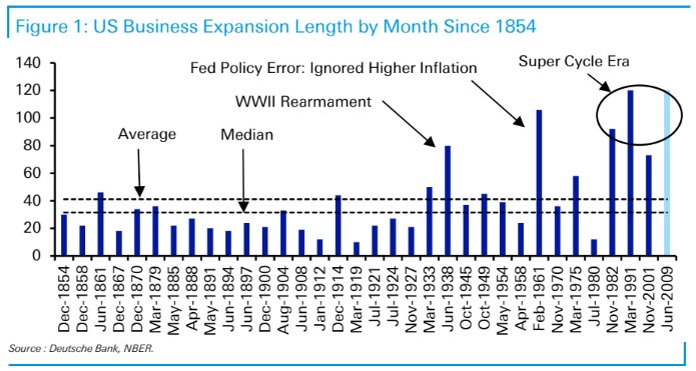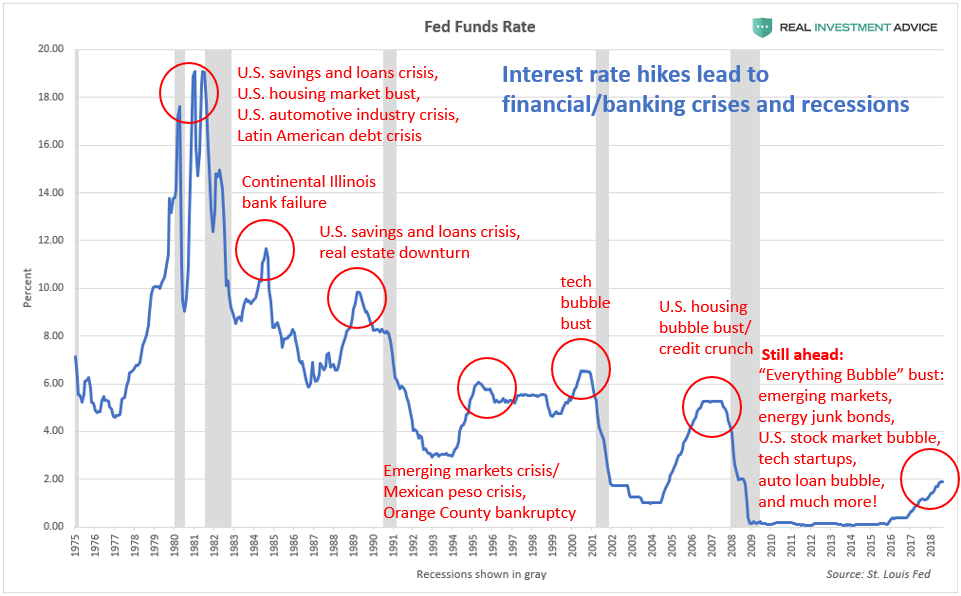Trying To Prevent Recessions Leads To Even Worse Recessions
Deutsche Bank strategists Jim Reid and Craig Nicol wrote a report this week that echos what I and other Austrian School economists been saying for many years: actions taken by governments and central banks to extend business cycles and prevent recessions lead to even more severe recessions in the end. MarketWatch reports –
(Click on image to enlarge)

The 10-year old economic expansion will set a record next month by becoming the longest ever. Great news, right? Maybe not, say strategists at Deutsche Bank.
Prolonged expansions have become the norm since the early 1970s, when the tight link between the dollar and gold was broken. The last four expansions are among the six longest in U.S. history .
Why so? Freed from the constraints of gold-backed currency, governments and central banks have grown far more aggressive in combating downturns. They’ve boosted spending, slashed interest rates or taken other unorthodox steps to stimulate the economy.
“However, there has been a cost,” contended Jim Reid and Craig Nicol at the global investment bank Deutsche Bank.
“This policy flexibility and longer business cycle era has led to higher structural budget deficits, higher private sector and government debt, lower and lower interest rates, negative real yields, inflated financial asset valuations, much lower defaults (ultra cheap funding), less creative destruction, and a financial system that is prone to crises,’ they wrote in a lengthy report.
“In fact we’ve created an environment where recessions are a global systemic risk. As such, the authorities have become even more encouraged to prevent them, which could lead to skewed preferences in policymaking,” they said. “So we think cycles continue to be extended at a cost of increasing debt, more money printing, and increasing financial market instability.”
As I have explained in the past, when central banks like the U.S. Federal Reserve cut interest rates to low levels, they manage to create economic booms by encouraging borrowing and higher asset prices. These economic booms are often based on dangerous economic bubbles that burst and lead to recessions when interest rates are normalized again. As the chart below shows, financial crises and recessions (see the gray vertical bars) occur after rate hike cycles, including the dot-com and U.S. housing market crashes.
(Click on image to enlarge)

After the Great Recession, the Fed and other central banks held interest rates at record low levels for a record length of time in order to encourage another economic boom. The central banks got their economic boom, alright, but it’s based on the inflation of these extremely dangerous bubbles: global debt, China, Hong Kong, Singapore, emerging markets, Canada, Australia, New Zealand, European real estate, the art market, U.S. stocks, U.S. household wealth, corporate debt, leveraged loans, U.S. student loans, U.S. auto loans, tech startups, shale energy, global skyscraper construction, U.S. commercial real estate, the U.S. restaurant industry, U.S. healthcare, and U.S. housing once again. I believe that the coming recession is likely to be caused by the bursting of those bubbles (read my detailed explanation).
The false economic booms that occur when central banks interfere with the business cycle trick investors and entrepreneurs into thinking that they are organic and sustainable booms. When the booms inevitably turn to busts, the bad investments that result are known as malinvestments –
Malinvestment is a mistaken investment in wrong lines of production, which inevitably lead to wasted capital and economic losses, subsequently requiring the reallocation of resources to more productive uses. “Wrong” in this sense means incorrect or mistaken from the point of view of the real long-term needs and demands of the economy, if those needs and demands were expressed with the correct price signals in the free market.
Random, isolated entrepreneurial miscalculations and mistaken investments occur in any market (resulting in standard bankruptcies and business failures) but systematic, simultaneous and widespread investment mistakes can only occur through systematically distorted price signals, and these result in depressions or recessions. Austrians believe systemic malinvestments occur because of unnecessary and counterproductive intervention in the free market, distorting price signals and misleading investors and entrepreneurs.
For Austrians, prices are an essential information channel through which market participants communicate their demands and cause resources to be allocated to satisfy those demands appropriately. If the government or banks distort, confuse or mislead investors and market participants by not permitting the price mechanism to work appropriately, unsustainable malinvestment will be the inevitable result.
Because the current economic cycle has lasted for an unusually long time due to the actions of central banks, an unprecedented amount of malinvestment has built up globally that needs to be cleansed in the coming recession. It’s similar to a night of drinking: the more you drink and the later you stay out, the worse your hangover is going to be. Globally speaking, the last decade has been the bender to end all benders and the coming hangover is going to proportionally severe.
For the author's full disclosure policy, click here.



